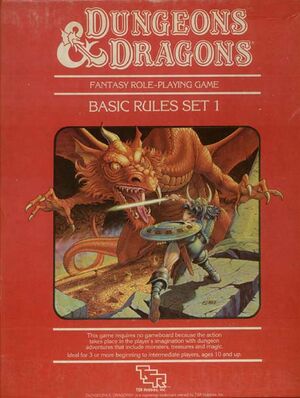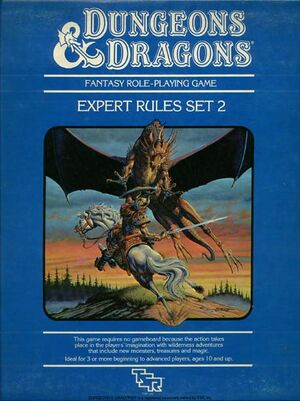Dungeons & Dragons: Difference between revisions
1d4chan>FlintTD |
|||
| Line 45: | Line 45: | ||
====Basic Set==== | ====Basic Set==== | ||
This had everything you needed for characters level 1-3. It included a Players book and a DMs book and a small adventure ([[Keep on the Borderlands]]). Some printings had 3 hole punch in the books to allow people to keep them in a binder easily. It also included a set of dice. The books only printed material relevant for characters from levels 1-3 and so were much smaller than the average RPG book. This allowed them to be sold cheaply. | This had everything you needed for characters level 1-3. It included a Players' book and a DMs' book. The Players' book came with a tutorial and a solo adventure for a starting fighter. That plot continued in a small adventure in the DMs' book, named ([[Keep on the Borderlands]]). Some printings had 3 hole punch in the books to allow people to keep them in a binder easily. It also included a set of dice. The books only printed material relevant for characters from levels 1-3 and so were much smaller than the average RPG book. This allowed them to be sold cheaply. | ||
====Expert Set==== | ====Expert Set==== | ||
Revision as of 18:48, 20 September 2012
| Dungeons & Dragons | ||
|---|---|---|
 |
||
| RPG published by Wizards of the Coast (TSR originally) |
||
| Authors | Gary Gygax Dave Arneson |
|
| First Publication | 1974 (D&D Original) 1977 (D&D 1st Revision) 1977–79 (AD&D 1st Edition) 1981 (D&D 2nd Revision) 1983-1986 (D&D 3rd Revision) 1989 (AD&D 2nd Edition) 1991 (D&D 4th Revision) 2000 (D&D 3rd Edition) 2003 (D&D v.3.5) 2008 (D&D 4th Edition) |
|
Dungeons & Dragons began as a crossover project by Gary Gygax and Dave Arneson in the early 1970s. Arneson's concept was to take the individual hero from Chainmail and tell his story. Gygax and Arneson collaborated on a project to realize this goal, and at Gen Con in 1974, they sold copies of the resulting game, Dungeons & Dragons. The game contained three small books in a brown box with white labels. (People often confuse the nearly identical white box (1978) with the actual original) The White Box was labeled with Original Collectors Edition to differentiate it from the newer Basic set being released around that time. In any case, this spawned the roleplaying game genre as we know it.
Versions
Original Dungeons & Dragons

Posthumously named, Dungeons & Dragons was directly linked to Chainmail in many ways. The Chainmail books even fit in the box. By adding multiple hero types to play and focusing on the aspect of the individual rather than the unit of the army, Gygax and Arneson kickstarted the Role Playing Game industry. People were no longer content to read tales of high fantasy in a book, not when they could control what the characters did! Dungeons & Dragons was released as a core set of 3 books and supplements were to follow later.
Dungeons & Dragons Contents
- Men & Magic - Allowed you to create a character and to learn the magic system.
- Monsters & Treasure - Pretty much exactly that. Rules for monster encounters and appropriate rewards for such.
- Underworld & Wilderness Adventures - The meat and potatoes of exploring overland and dungeon.
- Reference sheets - A stapled collection of pages with cross referencing tables and charts on them.
Supplements
- Supplement I Greyhawk - Introduced Oerth, new classes and spells and items and optional rules.
- Supplement II Blackmoor - Introduced TONS of items and optional rules.
- Supplement III Eldritch Wizardry - A lot of new magic rules and classes
- Supplement IV Gods, Demi-Gods, & Heroes - Rules for immortals, more classes, introduced the Paladin class.
- Supplement V Swords & Spells: More combat and magic rules, more game mechanics. This would be incorporated into AD&D later.





Basic Dungeons & Dragons
While Gygax was busy making "Advanced" Dungeons & Dragons, a guy named Holmes worked on a version that simplified the game, making it more accessible, and more on par with the original 1974 release in complexity. The systems were not really compatible however. Still, sales of the basic version exceeded those of the Advanced version for a few years. The system was a stepped system, meaning you could just buy the Basic book at a relatively low cost (around $7) and if you wanted to advance your character past level 3, you could buy the Expert books and so on. Each book in each set was available separately.
Basic Set
This had everything you needed for characters level 1-3. It included a Players' book and a DMs' book. The Players' book came with a tutorial and a solo adventure for a starting fighter. That plot continued in a small adventure in the DMs' book, named (Keep on the Borderlands). Some printings had 3 hole punch in the books to allow people to keep them in a binder easily. It also included a set of dice. The books only printed material relevant for characters from levels 1-3 and so were much smaller than the average RPG book. This allowed them to be sold cheaply.
Expert Set
This allowed you to advance from level 4 to level 14.
It came with another module (X1 Isle of Dread) and another set of dice.
It added a few more rules and more material relevant to characters of mid level.
Companion Set
Levels 15-25 were covered here.
If you bought the box set you got another set of dice as well.
Higher level magic, more monsters and such.
Master Set
Levels 26-36.
This was for super high level campaigns.
The largest and nastiest monsters, the most powerful spells and rules for even running your own settlements.
Box set came with another set of the cheap, easily destroyed Crayola Dice.
Immortals Set
For when levels mean precisely dick.
This has rules for gods. It has to, who else is going to stand up to you?
Another set of dice in this box, along with writeups on classical gods of mythology.
D&D Rules Cyclopedia
The rules Cyclopedia essentially was a compiled version of all the rules in the first four Basic D&D sets. The Immortals Set was reworked into the book Wrath of the Immortals. There were minor rule tweaks, but nothing drastic.
The Dungeons and Dragons Game

This box set was a comprehensive guide to roleplaying. It came with Dice, a map, a detailed book that stepped you through an adventure to generate your character and learn the fundamentals of role-play. (Xanzer Tem's dungeon)


